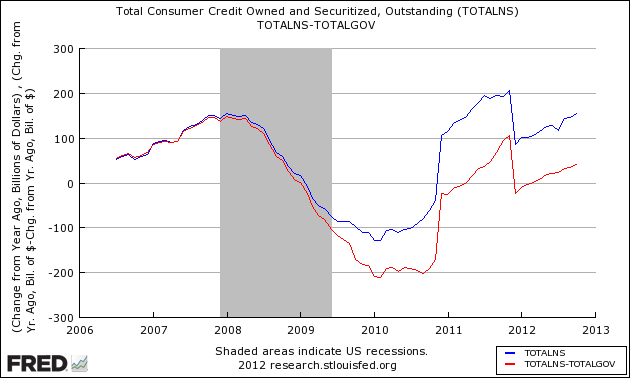Over the long Christmas Holiday weekend, The New York Times published For Poor, Leap to College Often Ends in a Hard Fall. The post is an anecdotal essay correlating being poor and the inability of those who are poor to become higher educated. This post shows how easy it was for the starring subjects to get loans, and how easy it was not to graduate and be stuck with bill anyway.
Monthly, we report on consumer credit noting that the majority of money flows into consumer credit is due to student loans.
The red line on the above graph is the growth of consumer credit after subtracting student loans. Currently, not considering student loans – consumer credit is growing at $200 per year for every person 18 years or older in the USA.
Student loans, however, are not obtained by the majority of the population – most is targeted to a small group 18 to 26 years old. The average debt burden on this segment per capita is growing at an annual rate exceeding $2,000.
Here are some random statistics from the American Student Assistance (ASA) website:
- close to 12 million – or 60% of all students – borrow annually to help cover costs.
- there are approximately 37 million student loan borrowers with outstanding student loan – and 14%, or about 5.4 million borrowers, have at least one past due student loan account.
- among all bachelor’s degree recipients, median debt was about $7,960 at public four-year institutions, $17,040 at private not-for-profit four-year institutions, and $31,190 at for-profit institutions.
- the average student loan balance for all age groups is $24,301.
- nearly 30 percent of college students who took out loans dropped out of school, up from fewer than a quarter of students a decade ago.
- more than half of students who take out loans to enroll in two-year for-profit colleges never finish. At traditional nonprofit and public schools, the percentage of students with loans who started college in 2003 and dropped out within six years is about 20 percent.
One significant factor that differentiates the U.S. from other countries: Many countries educate their young at no cost to the students. It remains to be determined by other analysis which approach to funding higher education has any economic advantage. At this juncture it appears that a generation is being saddled with debt they may not be able to repay – and that could well be the deciding factor in the economic analysis.
My weekend posts are geared to identifying specific elements of the USA economic system which are creating growing headwinds for future economic growth. It is hard to believe student loans are a healthy societal benefit (or investment) in the future. However, I have difficulty espousing solutions:
- Is higher education’s purpose to provide specific skill sets, or just provide a broad general education for employers to finish the training? Are we graduating too many “arts” degrees?
- With reduced funding levels, high school (secondary school) is graduating students with no specific skills. Should secondary education be teaching specific skill sets such as mechanics, welding, agriculture, etc?
- Should higher learning institutions be burdened with responsibility for educating in fields where there are jobs? Should the government be involved? Business?
- Should students be counseled before deciding their course of study (specifically jobs availability) or taking any student loan (showing how this burdens their future options)?
Other Economic News this Week:
The Econintersect economic forecast for December 2012 shows weak growth. The underlying dynamics continue to have a downward bent. There are recession markers still in play, and one of our alternate methods to validate our forecast is recessionary. All in all, not a great forecast – but not one which would cause you to jump out the nearest window either.
ECRI believes the recession began in July 2012. ECRI first stated in September 2011 a recession was coming . The size and depth is unknown. The ECRI WLI growth index value has been weakly in positive territory for over three months. The index is indicating the economy six month from today will be slightly better than it is today.
Current ECRI WLI Growth Index

Initial unemployment claims rose from 361,000 (reported last week) to 350,000 this week. Historically, claims exceeding 400,000 per week usually occur when employment gains are less than the workforce growth, resulting in an increasing unemployment rate (background here and here).
The real gauge – the 4 week moving average – continued to fall from 367,750 (reported last week) to 356,750. Because of the noise (week-to-week movements from abnormal events AND the backward revisions to previous weeks releases), the 4-week average remains the reliable gauge.
Weekly Initial Unemployment Claims – 4 Week Average – Seasonally Adjusted – 2010 (blue line), 2011 (red line), 2012 (green line)

Bankruptcies this Week: AuraSound
Data released this week which contained economically intuitive components(forward looking) were:
- Rail movements (where the economic intuitive components indicate a moderatelyslightly expanding economy).
- There were many important data releases this week which some use to forecast – durable goods, personal income – even gdp – I see little intuitive in these measures except trend lines.
Click here to view the scorecard table below with active hyperlinks.

